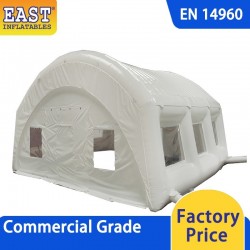25 Jul


Inflatable tents represent a significant innovation in camping gear, utilizing air-filled structures to provide a stable and easy-to-set-up shelter. Here’s a comprehensive guide on how these modern tents function:
Core Features of Inflatable Tents
- Air-Filled Supports: Unlike traditional tents with poles, inflatable tents use air-filled beams to support the structure. These beams are constructed from durable, flexible materials that can hold air pressure and provide stability.
- Inflation Valves: Each beam is equipped with valves that allow for quick inflation and deflation. These valves ensure that the air remains in the beams, maintaining the tent’s shape.
- High-Performance Fabrics: The fabric of inflatable tents is made from robust, waterproof materials such as polyester or nylon, which offer protection against the elements.
- Inflation Device: To set up the tent, you’ll use a pump—manual or electric—to inflate the beams. This device is essential for the quick assembly of the tent.
Setting Up Your Inflatable Tent
- Prepare the Site: Lay the tent out flat on a clear, level area to ensure an even setup.
- Inflate the Beams: Connect the pump to the valves and begin inflating the beams. This process usually takes just a few minutes, depending on the size of the tent and the pump's efficiency.
- Adjust the Shape: As the beams expand, they will begin to form the tent’s structure. Make any necessary adjustments to ensure the tent fabric is taut and aligned.
- Secure the Tent: Use stakes and guy lines to anchor the tent to the ground, which is crucial for stability in adverse weather conditions.
Strength and Reliability
- Structural Strength: Inflatable beams are designed to be robust, providing a stable framework that is comparable to, if not better than, traditional pole-supported tents.
- Durability: The materials used are engineered to resist punctures and wear. Many inflatable tents come with repair kits to address minor damages.
Benefits of Inflatable Tents
- Convenient Setup: Setting up an inflatable tent is typically faster and easier than traditional tents, making it ideal for quick camping trips.
- Compact Storage: Once deflated, inflatable tents are compact and easy to pack away, simplifying transportation and storage.
- Reduced Injury Risks: With no rigid poles, there’s less risk of injury from broken components, adding an extra layer of safety.
Considerations and Limitations
- Dependence on a Pump: Inflatable tents require a pump for setup, which means you need to carry and maintain this equipment.
- Potential for Punctures: Although durable, inflatable beams can still be punctured. While repair kits can handle minor issues, significant damage may need professional repair.
- Higher Price Point: The advanced materials and technology used in inflatable tents often make them more expensive than traditional tents.
Breaking Down the Packing Process
- Deflate the Beams: Release the air from the beams by opening the valves.
- Fold and Pack: Once deflated, fold the tent neatly and roll it up to prepare it for storage.
- Store Properly: Place the tent and pump into their storage bag to keep everything organized and ready for the next adventure.
Inflatable tents are a groundbreaking addition to camping gear, offering a blend of ease, efficiency, and modern design. Their ability to simplify setup and storage makes them a popular choice for both novice and experienced campers.




Leave a Comment